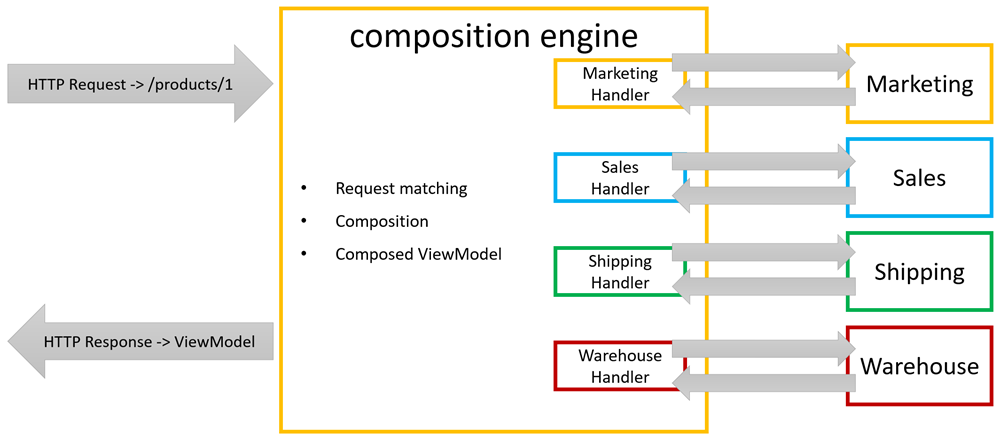
ViewModel Composition: show me the code!
The ViewModel Composition discovery journey is progressing nicely, so far we’ve discussed:
- What problem is Services ViewModel Composition designed to solve in What is Services ViewModel Composition, again?
- How is Single Item Composition designed in The Services ViewModel Composition maze
- How is ViewModels Lists Composition designed in Into the darkness of ViewModels Lists Composition
Looking for a ViewModel Composition framework? Take a look at the open source ServiceComposer.AspNetCore.
Show me the code!
It’s probably the right time to start looking at some code, maybe still some theoretical and pseudo code, but at least something that explains how to put in practice what we’ve discovered so far.
I’ll be using .NET and C# as it is my field of expertise. All that I’m showing can be achieved using different languages and platforms.
Let’s keep this simple by looking at Single Item Composition first. Pursuing the Product sample we used so far, we identified the following:
- Each product is identified by a unique
key. - Multiple services share the aforementioned key and use it to identify pieces of data that describe the Product from their point of view. As a recap we said:
- Marketing owns name and description.
- Sales owns price.
- Warehouse owns availability.
- Shipping owns shipping options.
- Whenever a Product is requested, each service needs to participate in the request handling and augment the returned product, the ViewModel, with its data.
If each service needs to be able to participate in the request handling process we could start by designing something like:
interface IHandleRequests
{
Task Handle(dynamic vm, RouteData routeData, HttpRequest request);
}
Whenever a request comes into the system it’ll be handled by something we can call Composition Engine for now that creates an empty ViewModel, the dynamic vm argument above, and invokes all the implementers of the IHandleRequests interface.
IHandleRequestsimplementations, given the currentRouteDataand the currentHttpRequestneed to make a decision first: am I interested in this specific request? Or put another way: is this for a Product or for something else?
We’re probably assigning too many responsibilities to the Handle implementation so we can enhance the situation by changing the above interface as follows:
interface IHandleRequests
{
bool Matches(RouteData routeData, string httpVerb, HttpRequest request);
Task Handle(dynamic vm, RouteData routeData, HttpRequest request);
}
The Matches method’s responsibility is to determine if the current HttpRequest is of interest for a given request handler. Introducing the Matches method means that the mentioned Composition Engine has the following behavior:
- Handles an incoming request
- Iterates over all request handlers calling the
Matchesimplementation - If there is any handler interested in the current request
- Creates and empty
ViewModel - Calls all the interested handlers
Handleimplementations
- Creates and empty
Thinking about a Product, one possible implementation, eg. for Marketing, could be:
class MarketingProductDetailsGetHandler : IHandleRequests
{
public bool Matches(RouteData routeData, string httpVerb, HttpRequest request)
{
var controller = (string)routeData.Values["controller"];
var action = (string)routeData.Values["action"];
return HttpMethods.IsGet(httpVerb)
&& controller.ToLowerInvariant() == "products"
&& action.ToLowerInvariant() == "details"
&& routeData.Values.ContainsKey("id");
}
}
The MarketingProductDetailsGetHandler Matches method inspects the current HttpRequest and based on its status determines if it is interested in handling it or not. In case it is interested it returns true and the Composition Engine will invoke the Handle method, that could look similar to:
class MarketingProductDetailsGetHandler : IHandleRequests
{
public bool Matches(RouteData routeData, string httpVerb, HttpRequest request)
{
/* omitted for clarity */
}
public async Task Handle(dynamic vm, RouteData routeData, HttpRequest request)
{
var id = (string)routeData.Values["id"];
var url = $"http://marketing.backend.local/api/product-details/product/{id}";
var response = await new HttpClient().GetAsync(url);
dynamic details = await response.Content.AsExpando();
vm.ProductName = details.Name;
vm.ProductDescription = details.Description;
}
}
At handling time the request handler loads data from its backend (in the above sample by forwarding an http request), but it could use whatever technique it wants. Once data are retrieved they are appended to the incoming ViewModel (dynamic vm).
At this point it’s probably clear that if all the services interested in a specific type of request, e.g. a Product details, deploy their own implementation of the IHandleRequests interface they can all participate in the ViewModel composition process.
Conclusion
The entire composition flow can be summarized as follows:

The composition engine handles the incoming request:
- Selects the interested handlers by invoking the
Matchesmethod. - Creates the empty ViewModel.
- Invokes the
Handlemethod of all the interested handlers. - Finally returns the composed ViewModel to the original caller
As we’ve already identified composing a list is more complex, we’ll get to that in the next article. We’ve also introduced this new Composition Engine that will be analyzed in a dedicated post.